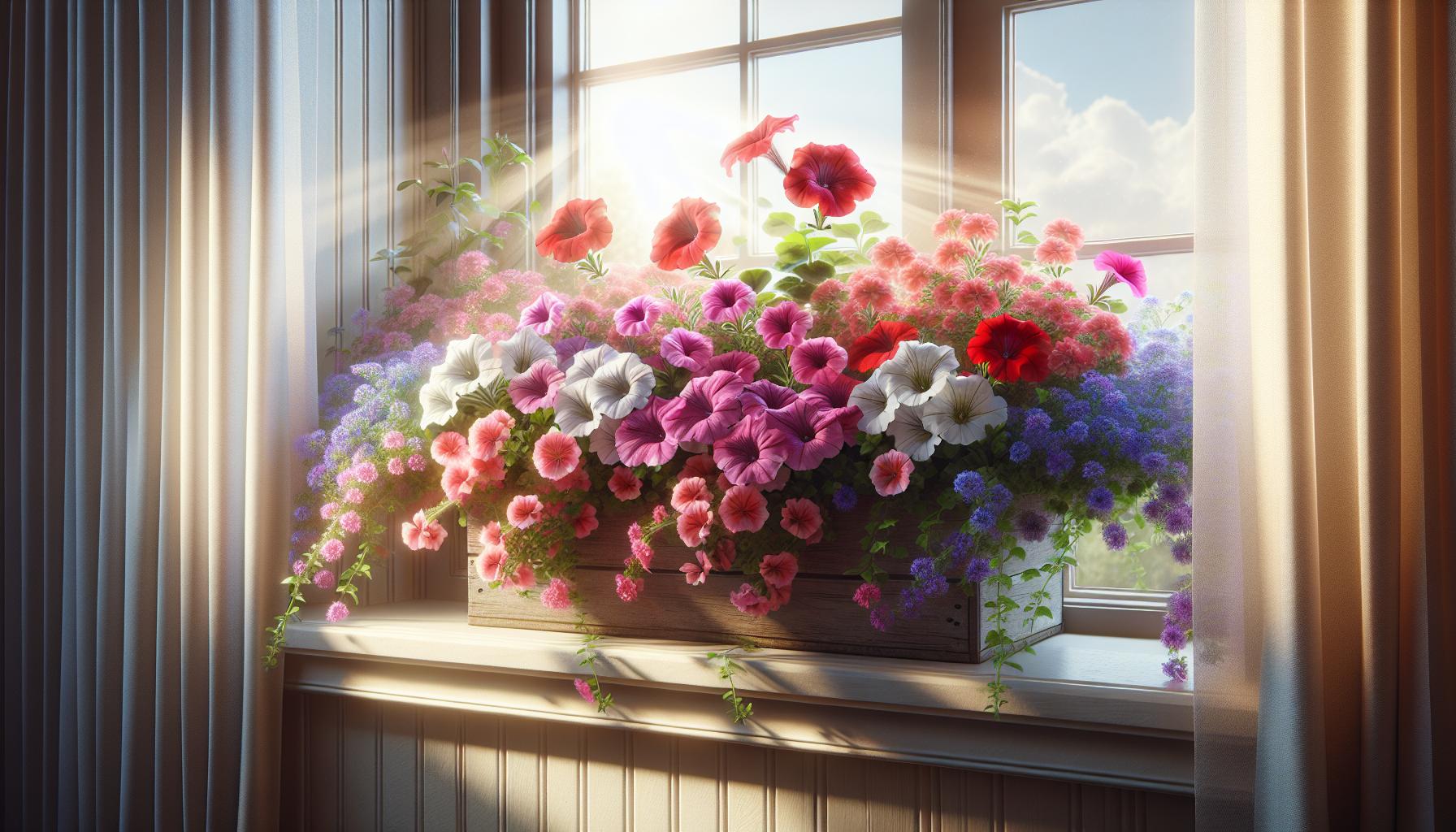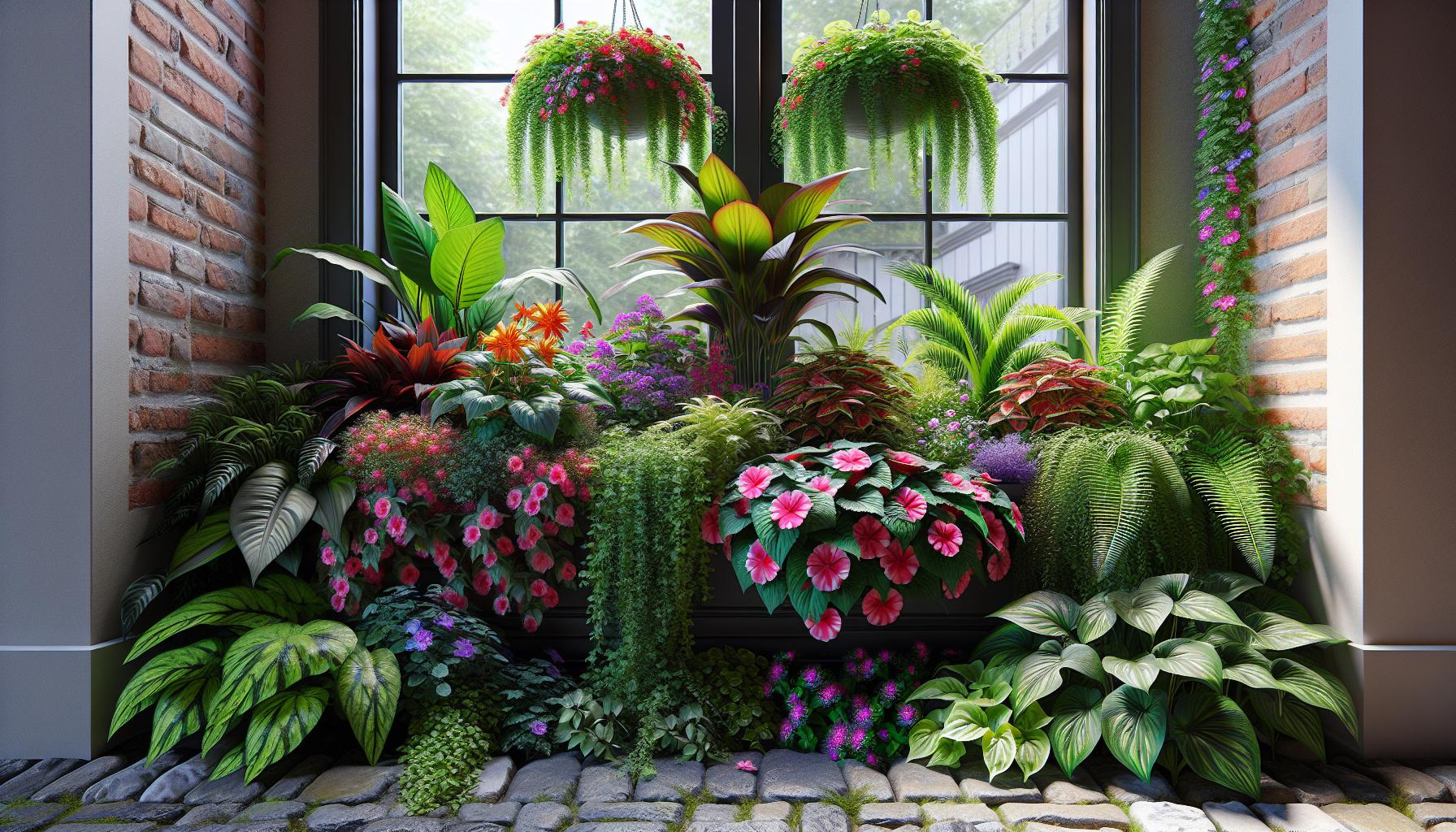There’s something magical about a well-planted window box that can transform the entire look of your home. But choosing the right plants can make all the difference. When considering what plants look best in a window box, it’s essential to think about balance, variety, and color coordination.
In this text, I’ll share some of my favorite plant combinations that not only thrive in window boxes but also create stunning visual appeal. From vibrant begonias to versatile geraniums, we’ll explore the best options to ensure your window box is a showstopper all season long.
Choosing the Right Plants for Your Window Box
Selecting the right plants for your window box transforms your home’s exterior. Careful planning ensures that each plant thrives while offering great visuals.
Consider Sun Exposure
Understanding sun exposure is crucial. If your window box gets full sun (six or more hours a day), choose plants like petunias, geraniums, and zinnias. These flowers thrive in sunny conditions and provide vivid colors. According to the Old Farmer’s Almanac, plants like nasturtiums and begonias also do well in full sun. For boxes in partial sun to shade, opt for impatiens, hostas, and coleus, which tolerate lower light levels. The University of Minnesota Extension highlights that begonias and fuchsias flourish in shady spots. Ensuring you match the plant to the box’s sun exposure is the first step to a successful display.
Factor in Plant Height and Structure
Plant height and structure play significant roles in window box design. I always follow the “thriller, filler, spiller” method for a balanced look. Thrillers are taller plants, like geraniums or salvia, which provide a focal point. Fillers, such as heliotrope or coleus, add volume and contrast. Spillers, including ivy or vinca, cascade over the box’s edge, softening the look. Clemson University Cooperative Extension suggests using climbers like ivy for added interest and height. Carefully arranging plants by height and form creates a cohesive and visually appealing window box.
Popular Plants for Sunlit Window Boxes

Petunias and Geraniums: Colorful and Vibrant
Petunias are great for adding vibrant color to any sunny window box. These flowers come in shades of white, red, pink, and purple, along with striped and fringed varieties. They’re tough, thriving even in summer’s harshest heat. Spreading petunias, like wave petunias, grow around 6 inches tall but can spread over 2 feet, filling the box with blooms so dense that foliage often goes unnoticed.
Geraniums offer another stunning option with their rich hues and robust nature. They produce clusters of flowers in red, pink, white, and more, standing tall and attracting attention effortlessly. A window box filled with petunias and geraniums not only adds color but also texture, as their differing growth patterns provide visual depth.
Marigolds and Zinnias: Sun-Loving Beauties
Marigolds are the definition of low-maintenance beauty for sunny spots. Their golden to orange blooms bring warmth and cheer to any window box. Standing between 6 inches to 3 feet tall, depending on the variety, these hardy flowers keep pests away while offering continuous blooms throughout the summer.
Zinnias are another sun-loving favorite, known for their vibrant and varied colors. They range in height from 6 inches to over 3 feet, making them versatile for any window box setup. Zinnias produce an abundance of flowers and can be mixed in various shades for a dynamic and engaging display. Both marigolds and zinnias thrive with minimal care, making them ideal for busy gardeners looking to add beauty without much fuss.
Ideal Plants for Shaded Window Boxes

Impatiens and Begonias: Bright in Low Light
Impatiens and begonias excel in shaded window boxes, thriving in areas with minimal direct sunlight. Impatiens, with their wide range of colors, from white and pink to red and purple, bring vibrant hues to any shaded spot. They bloom consistently throughout the summer, offering continual bursts of color. Besides, their compact growth makes them excellent for tight spaces.
Begonias are another excellent choice for shaded areas. Known for their glossy leaves and bright flowers, begonias come in various types like wax begonias and tuberous begonias. The wax begonias are particularly good for window boxes due to their resilience and elegant blossoms. Begonias also add a touch of sophistication with their stunning and often patterned foliage, making them dual-purpose plants for both flowers and foliage.
Coleus and Ferns: Texture and Color
Coleus and ferns bring texture and variety in color to shaded window boxes. Coleus plants are renowned for their vibrant and diverse foliage. They offer a spectrum of colors, including greens, reds, yellows, and purples, providing a colorful display without the need for flowers. These plants thrive in shaded conditions and can grow densely, creating a lush and full look in window boxes.
Ferns complement coleus with their elegant fronds and delicate texture. Maidenhair ferns and Boston ferns, for instance, provide intricate foliage that contrasts with the bold colors of coleus. Ferns excel in areas with indirect light and add a soft, feathery texture to your window boxes. They also mingle well with other shade-loving plants, creating a cohesive and dynamic composition.
To conclude, selecting the right plants for shaded window boxes ensures a thriving and visually appealing garden space, even in low-light conditions. Impatiens, begonias, coleus, and ferns each contribute unique elements, from bright flowers to textured foliage, making them ideal choices for shaded outdoor arrangements.
Adding Variety with Herbs and Vegetables

Culinary Herbs: Functional and Fragrant
Growing culinary herbs in a window box offers both aesthetic appeal and practical benefits. Herbs like basil, rosemary, parsley, and thyme bring fresh scents and add vibrant green hues to your window box. Basil, with its broad, bright green leaves, pairs well with tomatoes and is a favorite for home cooks due to its use in a variety of dishes. Rosemary offers a more intense green with needle-like leaves and an invigorating fragrance that can enhance the curb appeal of your home.
For those who enjoy garnishing their meals with a pop of freshness, parsley is a versatile choice. Its curly or flat leaves add texture and are easy to snip off for culinary use. Thyme, with its small, aromatic leaves and woody stems, not only serves as a cooking staple but also helps deter pests from other plants, making it a functional addition to your window box garden.
Small Vegetables: Edible and Decorative
Incorporating small vegetables into your window box provides both visual interest and a source of fresh produce. Cherry tomatoes are a popular choice due to their manageable size and vibrant red or yellow hues that stand out against green foliage. These tomatoes thrive in sunny conditions and can be easily harvested for salads or snacking.
Radishes are another excellent option, offering both color and quick growth. Their red, white, or purple roots can be harvested in as little as three to four weeks, providing almost instant gratification for gardeners. Also, their leafy tops contribute to the overall lush look of the window box.
Peppers, particularly smaller varieties like chili or bell peppers, add a splash of color and are perfect for culinary uses. These plants not only produce colorful fruits but also have attractive, bushy greenery that enhances the visual appeal of your window box.
By mixing culinary herbs and small vegetables, your window box becomes not only a visual feast but also a practical, edible garden. This combination ensures that your space is both beautiful and functional, providing fresh ingredients right outside your window.
Design Tips for Beautiful Window Boxes

Balancing Thrillers, Fillers, and Spillers
For a striking window box, balance thrillers, fillers, and spillers. Thrillers are tall plants that create a focal point. Traditional Geraniums are perfect thrillers with their upright growth and frequent blooms. Another option is the Dusty Miller, known for its 12 to 18-inch textured silver foliage, which contrasts beautifully with colorful flowers.
Fillers provide volume. Ivy Geraniums are great fillers that spill over the sides, adding a cascading effect. Coleus, with its multicolored leaves, offers another excellent choice, especially in partial shade or sun. It grows up to three feet, filling your window box with vibrant hues of pink, red, orange, green, and yellow.
Spillers are plants that hang over the edge of the window box. Sweet Potato Vine is a robust spiller that thrives in full sun. Spreading Petunias, growing about six inches tall but spreading over two feet, also make a fabulous spiller, producing abundant flowers that cover most of the foliage.
Seasonal Changes and Plant Rotation
Consider seasonal changes for vibrant window boxes year-round. In spring, opt for early bloomers like Violas and Pansies. These flowers thrive in cooler temperatures and provide a burst of color early in the season.
In summer, transition to heat-loving plants. Swap out spring blooms for Marigolds, Zinnias, and Salvia. These plants withstand higher temperatures and continue blooming throughout the season. Water your summer flowers regularly and deadhead spent blooms to keep them looking fresh.
Fall involves another rotation. Replace summer blooms with Mums and Ornamental Kale. These plants tolerate cooler temperatures and offer late-season color. Don’t forget about evergreens like small Conifers or Dwarf Boxwood. These provide structure and greenery during winter, ensuring your window box looks appealing even in the colder months.
Rotate plants not just for aesthetics but also for plant health. Frequent changeouts allow you to try different plants over the growing season and help prevent soil depletion and pest build-up, as emphasized by Adam Dooling from the New York Botanical Garden.
Strategically plan and rotate your window box plants, balancing thrillers, fillers, and spillers, to maintain a lush and vibrant display all year long.
Conclusion
Planting a window box can transform a dull space into a vibrant oasis. Choosing the right plants ensures visual appeal and promotes healthy growth. Here’s my selection of the best plants for window boxes, categorized by their specific benefits and aesthetic contributions.
Sun-Loving Plants
- Petunias: These come in various colors and thrive in full sun. Their cascading blooms spill over edges, adding a burst of color.
- Geraniums: Excellent for sunny spots. They offer striking blooms and are relatively low-maintenance.
- Marigolds: Known for bright, cheerful flowers, marigolds deter pests while decorating sunny window boxes.
- Zinnias: These sturdy flowers resist heat and stand tall, providing vibrant color from summer to frost.
Shade-Loving Plants
- Impatiens: With numerous color varieties, impatiens bloom profusely in shaded areas.
- Begonias: These versatile plants flourish in both semi-shade and full shade, boasting beautiful foliage and flowers.
- Coleus: Known for their striking foliage, coleus plants thrive in shade, offering a rainbow of leaf colors.
- Ferns: Adding lush greenery, ferns can bring texture and life to shaded window boxes.
Herbs and Small Vegetables
- Basil: Thrives in partial sun and offers fragrant leaves for culinary use.
- Parsley: Hardy herb that grows well in shaded or sunny spots.
- Lettuce: Compact growth makes lettuce ideal for window boxes; it thrives in cooler temperatures.
- Radishes: Quick-growing and can thrive in small spaces with adequate sunlight.
Design Tips: Thrillers, Fillers, and Spillers
- Thrillers: Tall plants like Geraniums and Dusty Miller provide height and serve as focal points.
- Fillers: Plants such as Ivy Geraniums and Coleus add volume and color between thriller plants.
- Spillers: Varieties like Sweet Potato Vine and Spreading Petunias cascade over the edges, softening the lines of the box.
- Spring: Early bloomers like pansies and violas bring fresh color.
- Summer: Heat-loving plants like zinnias and marigolds

